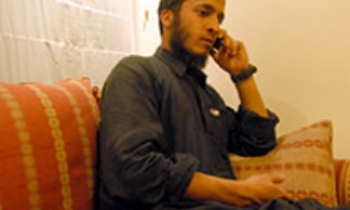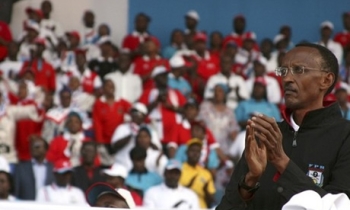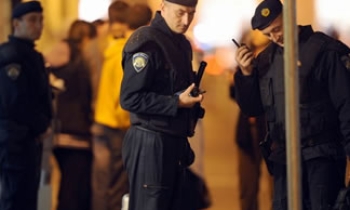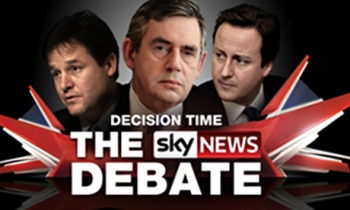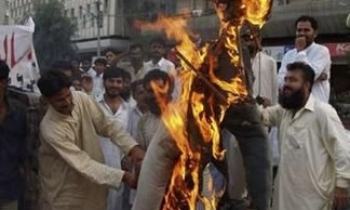WE HAVE, of course, seen it all before. That the printing of cartoons depicting the Prophet Muhammad - particularly wearing a bomb for a turban - would provoke hysteria and violence across the Muslim world was entirely predictable to anyone who remembers the book-burning and fatwa that followed the publication of Salman Rushdie's The Satanic Verses. Or indeed to anyone who has followed the rise of Islamic fundamentalism over the last few years.
Yet the ritual over-reaction to criticism of Islam remains as incomprehensible to those steeped in European sensibilities as the West's apparent refusal to hold anything sacred appears to most Muslims.
Images of gunmen taking over the EU building in Gaza and chants of "Death to Denmark" in Pakistan have inevitably re-opened the debate over freedom of speech (with the decision of British newspapers not to carry them being held up by some as symptomatic of the country's capitulation to the demands of Islamic fundamentalists). They have also hardened opposition towards the government's Racial and Religious Hatred Bill. But, perhaps more significantly, they have exposed the ideological gulf that continues to exist between Muslims and their adopted European countries and signalled the damage that can be inflicted by the failure of both communities to understand, never mind respect, each other's values.
There are few from a Western perspective who dispute the right of the newspapers involved to publish cartoons of Muhammad, Jesus or any "sacred" figure, regardless of the offence it might cause. One of the purposes of the media is to challenge prevailing views, and if that means taking a potshot at religion, then so be it.
Attempts at censorship are, in any case, self-defeating. Taking racists such as Nick Griffin to court only allows them to make a virtue of their own ignorance. The efforts by Muslims to force France Soir - one of the newspapers in which cartoons appeared - to apologise only led the paper to trumpet itself as the defender of democracy (despite having sacked the managing editor responsible).
At the same time, the right to free speech does not absolve us from our duty to behave responsibly. There seems to be no indication that the newspapers made a serious attempt to strike that balance.
While satire is an important weapon in the literary armoury, the point of it is surely to allow ordinary people to take a pop at the establishment, not the other way round. The Danish newspaper Jyllands-Posten, which first published the cartoons, and France Soir, may see themselves as taking on a great and iniquitous global force in the shape of Islamic fundamentalism, but in a local context this argument holds less water. Both countries have Muslim communities which are marginalised and dispossessed. A recent survey showed ethnic minorities in Denmark were disproportionately likely to be unemployed or in low-paid jobs, while France is still reeling from last year's riots. To decide to carry a cartoon that can be interpreted as branding all Muslims as potential terrorists against these backdrops is at the very least cavalier, and worse, an example of cynical rabble-rousing.
Not that any of this justifies burning flags, closing embassies, boycotting Danish goods or rounding up Scandinavians in Palestine. If Muslims want freedom of speech to express their grievances against their adopted homes, and freedom for their Imams to preach ideas which most Westerners find abhorrent, then clearly they have to accept the flipside: criticism of their own culture. Equally, if they want their own religion to be tolerated - then they have to be more tolerant of others'. It is impossible to put a convincing argument for censoring images of Muhammad on the grounds they are offensive while anti-semitic cartoons are appearing in Arabic newspapers.
What the current row has exposed is the chasm between East and West. Despite recent terrorist atrocities, it is easy to be complacent; to believe that in most European countries, Muslim communities co-exist quite happily with the indigenous population. It is only when an issue like this explodes that we get a truer insight into race relations in Britain and elsewhere.
The picture that has emerged is of two clashing cultures which continue to view each other with suspicion. On the one side are white Europeans, who are largely inured to "sacrilegious" images - Jesus in a nappy (Jerry Springer - The Opera) or Jesus as a "naughty little boy" (The Life Of Brian) - seeing them as a sign of a vibrant democracy. They have little affinity with a religion that denies iconography and which regards any challenge to its tenets as offensive.
On the other side are the many Muslims who find it difficult to get to grips with Western secularism and to accept the rights and duties democracy confers on its citizens. The most recent beneficiary of that political system - Hamas - for example, seems unable to grasp the relationship between the state and the individual, denouncing, as it did, the Danish government for failing to intervene over the publication of the cartoons.
Even the mildest of commentators seem confused by some of the principles the West holds dear. Take Osama Saeed, the Scottish spokesman for the Muslim Association of Britain, who disputed that a right to "ridicule or cause offence" exists.
Of course, the sudden outpouring of opinion also proves the point the cartoons missed - that neither culture is homogenous but encompasses a range of views, from rabid racist/fundamentalist to wishy-washy liberal.
It is too early to say whether the divisions that have been exposed will deepen or heal. It is, of course, possible that the debate will be hijacked by extremists on both sides, leading to further violence. But if, on the other hand, more reasoned thinkers in both cultures look on last week's events as an opportunity to rethink their own prejudices, and to try to understand the perspective of others, the cartoons may yet have a positive legacy which the editors of Jyllands-Posten and France Soir could never have predicted.

